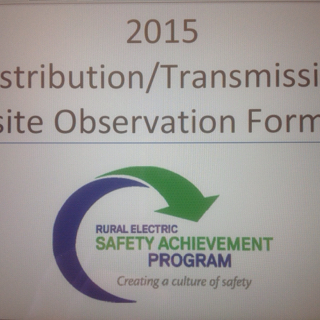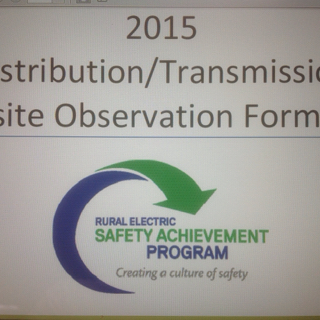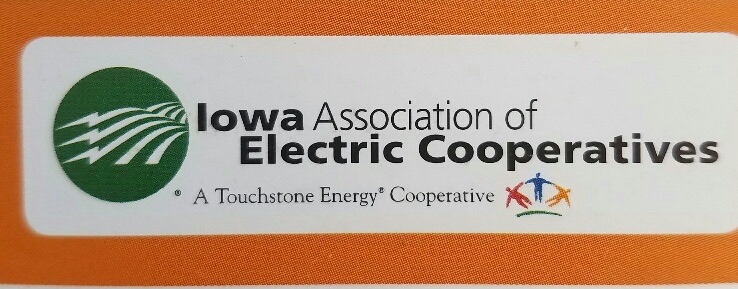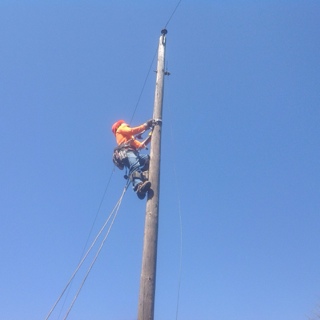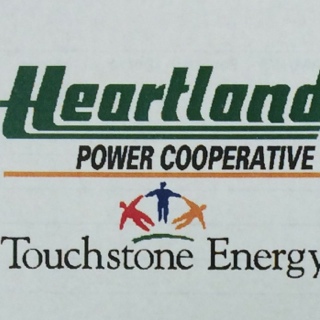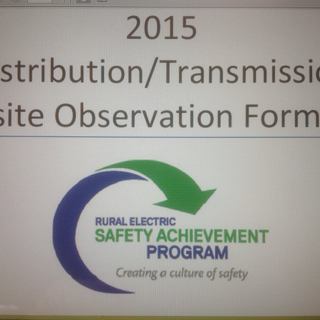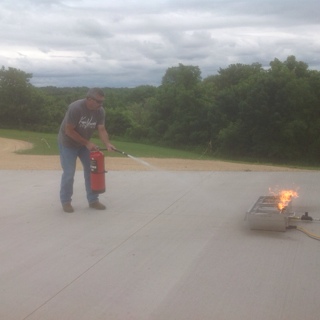Title Page
-
Cooperative Name
-
Location
-
- Main Facility
- Outpost
-
Conducted on
-
Prepared by
Section 9: Diggers, Buckets, Etc. (Over 10,000 Lbs. GVWR)
-
9.1 All digger derricks, aerial devices, and other commercial vehicles over 10,000 lbs. (GVWR) have six documents: insurance card, registration form, operator's manual, accident reporting guidelines, daily post trip inspections, and annual DOT meetings.<br>Criteria:<br>The post trip inspection should cover at least the following parts and accessories:<br>* Service brakes including trailer brake connections<br>* Parking brake<br>* Steering mechanism<br>* Lighting devices and reflectors<br>* Tires<br>* Horn<br>*Windshield wipers<br>* Rear vision mirrors<br>* Coupling devices<br>* Wheels and rims<br>* Emergency equipment<br>The report should identify the vehicles and list any deficiencies discovered which would affect the safe operation of the vehicle.<br><br>ref: FMCSA 396.11(post trip) & 396.13 (pre-trip)
-
9.2 Commercial vehicles over 10,000 ibs. GVWR are well maintained.<br>Criteria:<br>* Vehicles are washed regularly.<br>* Windows, mirrors, dash and cab are clean and uncluttered.<br>* The bed and storage areas are clean and free of trash and dirt.
-
9.3 Commercial vehicles are equipped with the proper safety equipment.<br>Criteria:<br>* Warning lights or strobes are well positioned for visibility from all directions and in working condition.<br>* Work zone safety equipment (signs, cones, stop/slow paddles, flashlight with wand, etc.) is available.<br>* Mounted or portable work lighting equipment is available.<br>* Roadside emergency triangular markers are on all of these vehicles.<br>* Road hazard flares or equivalent types of highway hazard warning devices are available.<br>* Vehicle brake, turn, marker, and headlamp lighting are 100% operational.
-
9.4 Body, jib, and boom winch mechanisms, cables, ropes, mounting, and controls are properly matched for the intended use and maintained in good condition. <br>Criteria:<br>* Winch cables and ropes are free of flat spots, kinks, broken strands, or frayed areas.<br>* Winch cables and ropes are equipped with proper rated hooks, eyes and attachments.
-
9.5 Appropriate vehicle grounding and/or barricading equipment is available and in good condition.<br>Criteria: <br>* Size of ground exceeds system's maximum available fault current.<br>* One end of the grounding cable is securely connected or can readily be connected to the equipment frame with a proper attachment. <br>* Grounding and/or barricading equipment is properly stored on the vehicle for vehicles used in energized work zones. <br>* For vehicles used in energized work zones. <br>
-
9.6 Vehicle ground cables are individually marked with a method of unique identification and date of most recent test.<br>Criteria:<br>* Vehicle ground clamps and cables are tested for continuity to frame if permanently attached or tested for current capacity if detachable.
-
9.7 Shovels, pry bars, tamps, ground rod drivers, sledges, chains, other heavy tools and materials are properly stored/secured in these utility vehicles. <br>Criteria:<br>* Tools and materials are stored in designated locations and in such a manner that they will not cause damage or be damaged.<br>* Protective guards, covers, and sheaths are in place.
-
9.8 At Least two effective wheel chocks are provided per large truck, properly placed in accordance with safety manual, and properly stowed on each truck when not in use. <br>Criteria:<br>* An effective wheel chock should be made of sturdy material, be wedge shaped and of adequate height to prevent movement.
-
9.9 Substantial outrigger pads are provided for all equipment outrigger legs, are properly used in accordance with manufacturer's requirements, and are properly stored on the vehicle when not in use. <br>
-
9.10 Manufacturer's identification, capacity ratings, warning signs, and equipment control placards for digger derrick and aerial basket devices are in place and in good condition. <br>Criteria:<br>* Signs, placards, and decals on these devices are readily visible, permanent, legible.<br>* Electrocution hazard warning signs for the public and employees are posted on devices that will be used in energized work zones.<br>* Equipment controls are clearly identified as to function and operation. <br>
-
9.11 Daily operational inspections are conducted before these vehicles leave the facility.<br>Criteria: <br>Before these vehicles leave the facility drivers should:<br>* Perform pre-trip procedures per operators manual (pre-flight operations, etc.) and co-op procedures and be satisfied that the vehicle is in safe operating condition.<br>*Review the last driver vehicle inspections report; and sign to certify that documented repairs have been made if applicable. <br><br>ref: FMCSA 396.11(post trip) & 396.13 (pre-trip)
-
9.12 Dielectric tests for these utility vehicles meets/exceeds applicable OSHA/ASTM/ANSI standards and results are available on or in each vehicle.<br>Criteria:<br>* While factors vary from co-op to co-op, RESAP generally encourages dielectric tests for these utility vehicles to be conducted on insulating and isolating components semi-annually (6 months) and results to be available on or in each vehicle, to be evaluated as "exceeds" requirements on this question. <br>* To "satisfy" this requirement dielectric tests can be conducted annually per regulatory requirements, on insulating and isolating components and results are available on or in each vehicle. <br>* Many factors enter into a cooperatives decision to determine frequency of dielectric testing vehicles, as example local environmental conditions, supporting work procedures and other logistical issues, RESAP wants to ensure a system satisfy OSHA requirements by conducting an annual test but promotes using a semi-annual (6months) dielectric test that exceeds the OSHA requirement. <br>* Booms are regularly cleaned and waxed according to sound operating practices. <br><br>ref: ANSI/SIA A92.2-2009 (ANSI Standard for Vehicle-Mounted Elevating and Rotating Aerial Devices)
-
9.13 Commercial Motor Vehicles (CMV) over 10,000 lbs. (GVWR) "if required" to haul cargo in interstate commerce - are registered with FMCSA and have a USDOT number.<br>Criteria:<br>* In select States (see list below), all registrants of commercial motor vehicles, even intrastate and non-Motor Carrier registrants are required to obtain a USDOT Number as a necessary condition for commercial vehicle registration.<br>* [Alabama, Alaska, Arizona, Colorado, Connecticut, Florida, Georgia, Indiana, Iowa, Kansas, Kentucky, Maine, Maryland, Michigan, Minnesota, Montana, New York, Nebraska, North Carolina, Ohio, Oklahoma, Oregon, Pennsylvania, South Carolina, Tennessee, Texas, Utah, Washington, West Virginia, Wisconsin, and Wyoming.]<br>In these cases each CMV should be marked on both sides with:<br>- Name of the cooperative,<br>- An identification number preceded by the letters "USDOT", and<br>- Letters that contrast sharply in color with the background on which the letters are placed, and, the letters are readily legible, during daylight hours from a distance of 50 feet while the CMV is stationary.<br><br>Regulatory References: 49 CFR 390.5; 49 CFR 390.21<br>*
-
9.14 Cargo is to be firmly immobilized or secured on or within a vehicle and/or pole trailers.<br>Criteria:<br>* Cargo must be:<br>- Secured to prevent the cargo from leaking, spilling, blowing or falling from the CMV, and/or<br>- Contained, immobilized or secured such that vehicle stability or maneuverability is not adversely affected.<br><br>Regulatory Reference: 49 CFR 393, Subpart I<br>
-
9.15 Employees can explain or demonstrate their daily vehicle inspection procedures for commercial motor vehicles.<br><br>ref: Federal Motor Carrier Safety Regulations
Section 9: Summary
-
9.16 The overall evaluation of the onsite field observation team for this section of the assessment is as follows:<br><br>Criteria:<br>* Strong performance - Questions evaluated as exceeds or satisfies all requirements<br>* Satisfactory performance - Questions evaluated as satisfies all requirements, could be a small number evaluated as exceeds.<br>* Generally satisfactory with minor areas for improvement - Questions evaluated as satisfies all or most requirements, improvement areas are minor.<br>* Ket attentions areas for improvement - Questions evaluated as partially satisfies or fails to satisfy requirements in important improvement areas.
IAEC Safety Personnel Signature
-
John Dvorak
-
Matt Pociask
-
Jim Wolfe
-
Scott Meinecke
